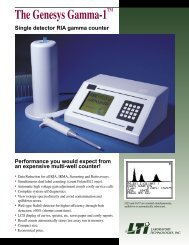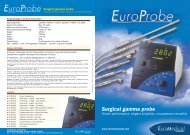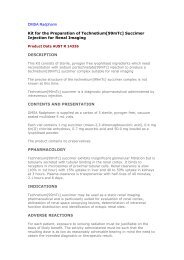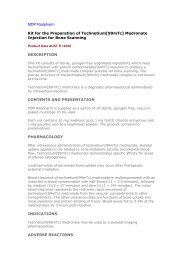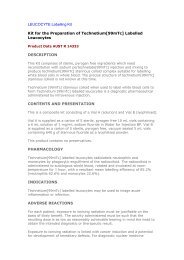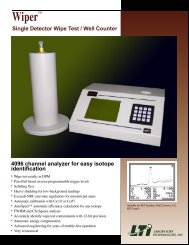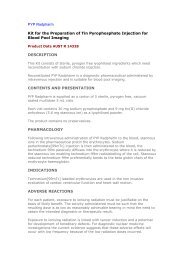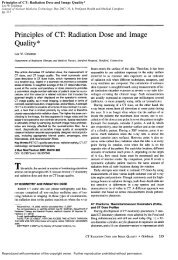DTPA Radpharm Kit for the Preparation of Technetium[99mTc ...
DTPA Radpharm Kit for the Preparation of Technetium[99mTc ...
DTPA Radpharm Kit for the Preparation of Technetium[99mTc ...
You also want an ePaper? Increase the reach of your titles
YUMPU automatically turns print PDFs into web optimized ePapers that Google loves.
<strong>DTPA</strong> <strong>Radpharm</strong><br />
<strong>Kit</strong> <strong>for</strong> <strong>the</strong> <strong>Preparation</strong> <strong>of</strong> <strong>Technetium</strong>[<strong>99mTc</strong>] Pentetate<br />
Injection <strong>for</strong> Renal Imaging<br />
Product Data AUST R 14327<br />
DESCRIPTION<br />
This <strong>Kit</strong> consists <strong>of</strong> sterile, pyrogen free lyophilised ingredients which need<br />
reconstitution with sodium pertechnetate[<strong>99mTc</strong>] injection to produce a<br />
technetium[<strong>99mTc</strong>] pentetate complex suitable <strong>for</strong> renal imaging.<br />
The precise structure <strong>of</strong> <strong>the</strong> technetium[<strong>99mTc</strong>] pentetate complex is not<br />
known at this time.<br />
<strong>Technetium</strong>[<strong>99mTc</strong>] pentetate is a diagnostic pharmaceutical administered by<br />
intravenous injection.<br />
CONTENTS AND PRESENTATION<br />
<strong>DTPA</strong> <strong>Radpharm</strong> is supplied as a carton <strong>of</strong> 5 sterile, pyrogen free, vacuum<br />
sealed 5 mL vials.<br />
Each vial contains 5 mg pentetic acid and 1 mg tin(II) chloride anhydrous as<br />
a lyophilised powder.<br />
The product contains no preservatives.<br />
PHARMACOLOGY<br />
Following intravenous administration <strong>of</strong> technetium[<strong>99mTc</strong>] pentetate to<br />
normal patients <strong>the</strong> radiopharmaceutical is rapidly distributed in <strong>the</strong><br />
extracellular fluid space <strong>the</strong>n cleared from <strong>the</strong> body through <strong>the</strong> kidneys.<br />
There is minimal binding to renal parenchyma and it clears <strong>the</strong> kidneys by<br />
glomerular filtration.<br />
The images taken in <strong>the</strong> first minutes demonstrate kidney vascular pool and<br />
subsequent images represent technetium[<strong>99mTc</strong>] pentetate in both <strong>the</strong><br />
collecting system and <strong>the</strong> renal pelvis.<br />
INDICATIONS<br />
<strong>Technetium</strong>[<strong>99mTc</strong>] pentetate may be used as a renal perfusion imaging<br />
pharmaceutical.<br />
CONTRAINDICATIONS<br />
None known.<br />
PRECAUTIONS
General<br />
Radiopharmaceuticals should be used only by physicians who are qualified by<br />
specific training in <strong>the</strong> safe use and handling <strong>of</strong> radionuclides.<br />
Contents <strong>of</strong> <strong>the</strong> vial/s are intended only <strong>for</strong> use in <strong>the</strong> preparation <strong>of</strong><br />
technetium[<strong>99mTc</strong>] pentetate.<br />
The radioactivity <strong>of</strong> <strong>the</strong> dose should be checked with a suitable instrument<br />
immediately prior to administration.<br />
Disposal <strong>of</strong> all radioactive wastes should be carried out in accordance with <strong>the</strong><br />
NH & MRC "Code <strong>of</strong> Practice <strong>for</strong> <strong>the</strong> Disposal <strong>of</strong> Radioactive Wastes by <strong>the</strong><br />
User" (1985).<br />
Use in Pregnancy<br />
<strong>Technetium</strong>-99m radiopharmaceuticals should only be given to a pregnant<br />
woman if in <strong>the</strong> judgement <strong>of</strong> <strong>the</strong> treating physician <strong>the</strong> expected benefits<br />
outweigh <strong>the</strong> potential hazards.<br />
Use during Lactation<br />
<strong>Technetium</strong>-99m is excreted in human milk. Interruption to breast feeding is<br />
necessary after <strong>the</strong> administration <strong>of</strong> technetium[<strong>99mTc</strong>] pentetate <strong>for</strong> a<br />
period less than 12h.<br />
(Reference: L.K. Harding, A. Bossuyt, S. Pellet, C. Reiners, J.N. Talbot,<br />
"Recommendations <strong>for</strong> nuclear medicine physicians regarding breastfeeding<br />
mo<strong>the</strong>rs", Eur.J.Nucl.Med., 1995, 22, BP17).<br />
ADVERSE REACTIONS<br />
For each patient, exposure to ionising radiation must be justifiable on <strong>the</strong><br />
basis <strong>of</strong> likely benefit. The activity administered must be such that <strong>the</strong><br />
resulting dose is as low as reasonably achievable bearing in mind <strong>the</strong> need to<br />
obtain <strong>the</strong> intended diagnostic or <strong>the</strong>rapeutic result.<br />
Exposure to ionising radiation is linked with cancer induction and a potential<br />
<strong>for</strong> development <strong>of</strong> hereditary defects. For diagnostic nuclear medicine<br />
investigations <strong>the</strong> current evidence suggests that <strong>the</strong>se adverse effects will<br />
occur with low frequency because <strong>of</strong> <strong>the</strong> low radiation doses incurred.<br />
For most diagnostic investigations using a nuclear medicine procedure <strong>the</strong><br />
radiation dose delivered (EDE) is less than 20 mSv. Higher doses may be<br />
justified in some clinical circumstances.<br />
In isolated cases <strong>the</strong> following adverse reactions have been reported: flushing,<br />
dizziness, dyspnoea, itch, urticaria and hypotension.<br />
Any suspected adverse reaction should be reported to Adverse Drug<br />
Reactions Advisory Committee (ADRAC) TGA, PO Box 100 WODEN ACT 2606.
Tel: 06 289 8670 Fax: 06 289 7694.<br />
DOSAGE AND ADMINISTRATION<br />
Recommended intravenous dose <strong>for</strong> <strong>the</strong> normal adult is 200 MBq.<br />
Procedure<br />
NOTE: If <strong>the</strong>re is no vacuum, discard vial and do not deliver <strong>the</strong> sodium<br />
pertechnetate[<strong>99mTc</strong>] injection.<br />
1. Place <strong>DTPA</strong> <strong>Radpharm</strong> vial in a shielding container.<br />
2. Draw a suitable volume (1 to 4 mL) <strong>of</strong> sodium pertechnetate[<strong>99mTc</strong>]<br />
injection eluted from a technetium-99m generator (1 to 3 GBq) and inject<br />
into <strong>the</strong> <strong>DTPA</strong> <strong>Radpharm</strong> vial. Mix by inversion <strong>for</strong> 30 seconds and leave<br />
standing at room temperature <strong>for</strong> 10 minutes be<strong>for</strong>e use.<br />
3. Determine <strong>the</strong> radioactivity per millilitre, label <strong>the</strong> container and calculate<br />
<strong>the</strong> patient dose.<br />
4. The technetium[<strong>99mTc</strong>] pentetate solution is stable at room temperature<br />
and may be used up to 5 hours after preparation.<br />
Stability after Reconstitution with <strong>Technetium</strong>-99m<br />
After reconstitution <strong>of</strong> <strong>DTPA</strong> <strong>Radpharm</strong> with sodium pertechnetate[<strong>99mTc</strong>]<br />
injection, (1 to 3 GBq), <strong>the</strong> technetium[<strong>99mTc</strong>] pentetate complex is stable at<br />
room temperature <strong>for</strong> 5 hours.<br />
STORAGE AND EXPIRY<br />
The <strong>DTPA</strong> <strong>Radpharm</strong> vials must be stored below 250C.<br />
Expiry is 12 months from <strong>the</strong> date <strong>of</strong> manufacture. The expiry date is stated<br />
on <strong>the</strong> vial and carton.<br />
MANUFACTURER<br />
This product is manufactured by <strong>Radpharm</strong> Scientific, Unit 3 Oatley Lane<br />
Belconnen, 2617 ACT Australia



